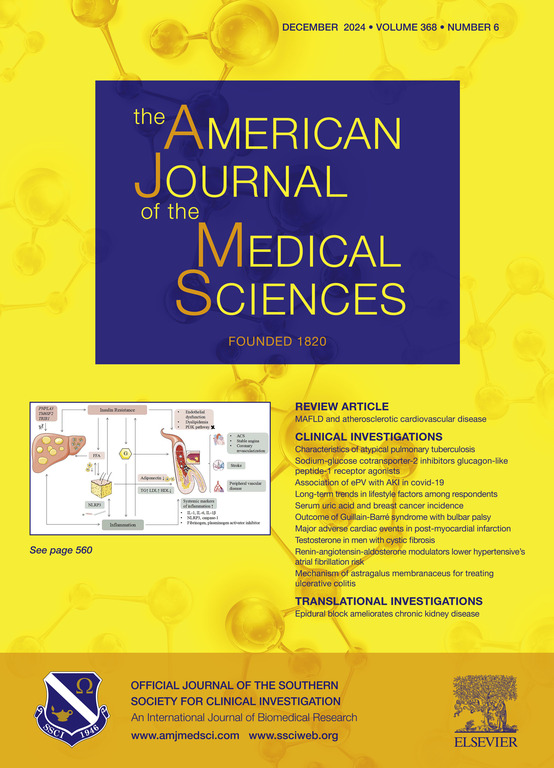尿液 Dickkopf-3 作为重症监护病房术后急性肾损伤的预测因子。
IF 1.8
4区 医学
Q2 MEDICINE, GENERAL & INTERNAL
引用次数: 0
摘要
背景:急性肾损伤(AKI)是威胁手术患者生命的一种并发症,与预后不良密切相关。尿Dickkopf相关蛋白3(DKK3)已被确定为预测心脏手术患者术后AKI的生物标志物:研究尿DKK3对术后AKI的预测价值,并根据该预测因子建立临床模型,以预测非心脏手术患者七天内发生AKI的情况:研究纳入了 2023 年 3 月至 2023 年 6 月期间非心脏手术后入住重症监护室(ICU)的所有患者。入院时收集患者的人口统计学特征、生活方式风险因素、病史、临床特征和手术前实验室检查等基线数据。此外,在入住重症监护室时,还同时采集了检测胱抑素 C 和常规实验室检查的血液样本以及检测 DKK3 的尿液样本。此外,还通过单变量、多变量和 LASSO 分析确定了术后 AKI 的独立预测因素。此外,还根据这些独立的预测因素制定了预测术后 AKI 的提名图。最后,通过校准和决策曲线分析对提名图进行了评估:本研究共纳入 166 例患者,中位年龄为 67 岁,其中男性 94 例(56.63%)。其中,47 名患者(28.3%)发生了术后 AKI。此外,通过单变量和多变量回归分析,筛选出了 7 个独立的风险因素,包括术前血清肌酐、术前 eGFR、术前血清白蛋白、术前血清钾离子、胱抑素 C、uDKK3/uCr 和 SOFA 评分。最终,本研究通过 LASSO 分析确定的 4 个独立风险因素(包括术前 eGFR、胱抑素 C、uDKK3/uCr 和 SOFA 评分)被用于建立提名图。预测模型的接收者操作特征曲线(ROC)下面积(AUC)为 0.868。校准曲线和决策曲线分析结果表明,提名图具有良好的预测性能:结论:尿DKK3/肌酐与ICU非心脏手术患者术后AKI有独立关联。基于尿DKK3/尿Cr、术前eGFR、胱抑素C和SOFA评分构建的提名图在预测术后AKI方面显示出更高的准确性。本文章由计算机程序翻译,如有差异,请以英文原文为准。
Urinary dickkopf-3 as a predictor for postoperative acute kidney injury in the intensive care unit
Background
As a life-threatening complication in patients undergoing surgery, acute kidney injury (AKI) is strongly associated with a worse prognosis. Urinary dickkopf-related protein 3 (DKK3) has been identified as a biomarker for predicting postoperative AKI in patients undergoing cardiac surgery.
Objective
To investigate the predictive value of urinary DKK3 on postoperative AKI and develop a clinical model based on the predictor for predicting the development of AKI within seven days for patients undergoing noncardiac surgery.
Methods
All patients who were admitted to the Intensive Care Unit (ICU) after noncardiac surgery from March 2023 to June 2023 were included in this study. The patients’ baseline data on demographic characteristics, lifestyle risk factors, medical history, clinical features, and laboratory tests before surgery were collected at the time of admission. Besides, the blood samples for cystatin C and routine laboratory tests and the urine samples for DKK3 tests were simultaneously collected at the time of admission to the ICU. In addition, the independent predictors of postoperative AKI were identified by univariate, multivariate, and LASSO analyses. Moreover, a nomogram for predicting postoperative AKI was developed based on these independent predictors. Finally, the nomogram was evaluated through calibration and decision curve analyses.
Results
A total of 166 patients with a median age of 67 years old were included in this study, including 94 (56.63 %) males. Among these patients, 47 patients (28.3 %) developed postoperative AKI. Additionally, 7 independent risk factors, including preoperative serum creatinine, preoperative eGFR, preoperative serum albumin, preoperative serum potassium ion, cystatin C, uDKK3/uCr, and SOFA score, were selected by univariate and multivariate regression analyses. Eventually, 4 independent risk factors (including preoperative eGFR, cystatin C, uDKK3/uCr, and SOFA score) identified in this study by LASSO analyses were used to establish the nomogram. The area under the receiver operating characteristic (ROC) curve (AUC) for the prediction model was 0.868. The calibration curve and decision curve analysis results demonstrated that the nomogram had good prediction performance.
Conclusions
Urinary DKK3/creatinine was independently associated with postoperative AKI for patients in the ICU after noncardiac surgery. The nomogram constructed based on uDKK3/uCr, preoperative eGFR, cystatin C, and SOFA score showed a higher accuracy in predicting postoperative AKI.
求助全文
通过发布文献求助,成功后即可免费获取论文全文。
去求助
来源期刊
CiteScore
4.40
自引率
0.00%
发文量
303
审稿时长
1.5 months
期刊介绍:
The American Journal of The Medical Sciences (AJMS), founded in 1820, is the 2nd oldest medical journal in the United States. The AJMS is the official journal of the Southern Society for Clinical Investigation (SSCI). The SSCI is dedicated to the advancement of medical research and the exchange of knowledge, information and ideas. Its members are committed to mentoring future generations of medical investigators and promoting careers in academic medicine. The AJMS publishes, on a monthly basis, peer-reviewed articles in the field of internal medicine and its subspecialties, which include:
Original clinical and basic science investigations
Review articles
Online Images in the Medical Sciences
Special Features Include:
Patient-Centered Focused Reviews
History of Medicine
The Science of Medical Education.

 求助内容:
求助内容: 应助结果提醒方式:
应助结果提醒方式:


